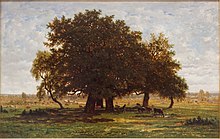I.展覽目錄是重要資源
其他專家研究主題 多本
---
米勒(Jean-François Millet)(西元1814.10.4—1875.1.20)
法國畫家。屬於自然主義的巴比松畫派。中年時為了維持生計必須下田耕作,因而得以描繪出純樸的田園風光,享譽世界畫壇。著名畫作包括《拾穗》、《晚禱》與《播種者》等。
百年多前的書,很可能還值得翻譯出版:
如果想要感動別人,就必須先感動自己。假如不這麼做,無論是多麼精巧的作品,也絕對沒有生命。
藝術不是消憂解悶的遊戲。而是一場戰役、一具絞碎物體的齒輪機械。
美的重點在於呈現。若要畫出自己的母親,就該抓住母親凝視孩子的時刻,施展全力畫出最美麗、最純粹的那個瞬間。
節自 朱里亞.卡萊德《米勒藝術史》
其實,親情,世界上多類似。 MILLET 的母親思念他,想生前一見的機會都沒有,這才是社會的悲劇。
Cherbourg (Normandy)
index 394~398Jozef Israëls (27 January 1824 – 12 August 1911) was a Dutch painter. He was a leading member of the group of landscape painters referred to as the Hague School and, during his lifetime, "the most respected Dutch artist of the second half of the nineteenth century".[1]
Sensibility[edit]
Israëls has often been compared to Jean-François Millet. As artists, even more than as painters in the strict sense of the word, they both, in fact, saw in the life of the poor and humble a motive for expressing with peculiar intensity their wide human sympathy; but Millet was the poet of placid rural life, while in almost all Israëls' pictures there is some piercing note of woe. Edmond Duranty said of them that they were painted with gloom and suffering.[4]
Paris, Barbizon and Amsterdam[edit]
In December 1873 Liebermann moved to Paris and set up a studio in Montmartre. In the world capital of art, he wanted to make contacts with leading realists and impressionists. But the French painters refused to have any contact with the German Liebermann. In 1874 he submitted his goose plucking to the Salon de Paris, where the picture was accepted but received negative reviews in the press, especially from a nationalist point of view. Liebermann first spent the summer of 1874 in Barbizon, near the Forest of Fontainebleau. "Munkácsy attracted me a lot, but Troyon, Daubigny, Corot and above all Millet did even more."[5]
The landscape painting en plein air practiced by painters of the Barbizon School was of great importance for the development of Impressionism. Liebermann turned away from the old-fashioned, heavy painting of Munkácsy, more interested in the methods of the Barbizon School than in the motives that influenced them: In Barbizon, for example, he remembered the Weimar study Arbeiter im Rübenfeld, looked for a similar motif and created the Potato Harvest in Barbizon, which he did not complete until years later. Ultimately, he tried to follow in Millet's footsteps and, in the opinion of contemporary critics, lagged behind him with his own achievements: The depiction of the workers in their environment seemed unnatural; it seemed as if they were added to the landscape at a later date.[5]
藝術與勤勞、傳承
Millet 怪法國諸文豪沒有留下它們對藝術的心得,來指導法國人民.....兩問題:
能夠這樣教化嗎?文學與藝術,兩回事.....
左拉不算
官方的獎與榮譽對於19世紀法國畫家.....Manet、Théodore Rousseau vs Corot
Renoir 一書中的 Barbizon
風景畫的兩傳統:
義大利-法國
英國-法國
***



 查看所有3圖像
查看所有3圖像J. F. Millet Exhibition, Museum of Fine Arts Boston Paperback – 1 1 月 1984
作者 Alexandra Murphy (Author)
Exhibition catalog featuring the artwork of 19th Century French Realist artist JF Millet. Over 170 color and black and white illustrations of works of art by Millet - paintings, drawing, sketches. Portraits, figures, landscapes. Includes chronology of the artist, exhibit checklist and bibliography. Softcover.
***
Millet與Théodore Rousseau的友情
Jean-François Millet (French: [milɛ]; October 4, 1814 – January 20, 1875)
Étienne Pierre Théodore Rousseau (April 15, 1812 – December 22, 1867) was a French painter of the Barbizon school.
Later years[edit]
Rousseau then suffered a series of misfortunes. His wife's mental health had worsened; his aged father became dependent on him for pecuniary assistance; his patrons were few. Moreover, while he was temporarily absent with his ill wife, a youth living in his home (a friend of his family) committed suicide in his Barbizon cottage. When he visited the Alps in 1863, making sketches of Mont Blanc, he became dangerously ill with inflammation of the lungs; and when he returned to Barbizon he suffered from insomnia and became gradually weakened.[1]
He was elected president of the fine-art jury for the 1867 Exposition; however, his disappointment at being denied the better awards may have affected his health, for in August he became paralyzed. He recovered slightly, but was again attacked several times during the autumn. In November his condition worsened, and he died in the presence of his lifelong friend, Jean-François Millet, on December 22, 1867. Millet, the peasant painter, for whom Rousseau had the greatest regard, had been much with him during the last years of his life, and at his death Millet assumed charge of Rousseau's ill wife.[1]
Rousseau's other friend and neighbor, Jules Dupré, himself an eminent landscape painter of Barbizon, relates the difficulty Rousseau experienced in knowing when his picture was finished, and how he, Dupré, would sometimes take away from the studio some canvas on which Rousseau was laboring too long. Rousseau was a good friend to Diaz, teaching him how to paint trees, for until a certain point in his career Diaz considered he could only paint figures.
| 24等他們過了河,也叫自己所有的過了河, |
| 25雅各伯獨自一人留在後面。有一人前來與他搏鬥一直到曙光破曉。 |
| 26那人見自己不能制勝,就在他的大腿窩上打了一下;雅各伯正在與他搏鬥之際,大腿窩脫了節。 |
| 27那人說:「讓我走罷!天已破曉。」雅各伯說:「你如果不祝福我,我不讓你走。」 |
| 28那人問他說:「你叫什麼名字?」他答說:「雅各伯。」 |
| 29那人說:「你的名字以後不再叫雅各伯,應叫以色列,因為你與神與人搏鬥,佔了優勢。」 |
| 30雅各伯問說:「請你告訴我你的名字。」那人答說:「為什麼你要問我的名字?」遂在那裏祝福了他。 |
| 31雅各伯給那地方起名叫「培尼耳」,意謂「我面對面見了神,我的生命仍得保全」。 |
| 32雅各伯經過培尼耳時,太陽已升起照在身上,由於大腿脫了節,他一走一瘸。 |
| 33為此,以色列子民至今不吃大腿窩上的筋,因為那人打了雅各伯的大腿窩,正打在筋上。 |
Étienne Pierre Théodore Rousseau (April 15, 1812 – December 22, 1867) was a French painter of the Barbizon school.






沒有留言:
張貼留言